Winterizing a rain barrel is a must if you live in a cold climate like I do. Leaving it full of water when the temps drop below freezing could severely damage, if not destroy it. In this post, I’ll show you exactly how to prepare and store a rain barrel for winter, step by step.
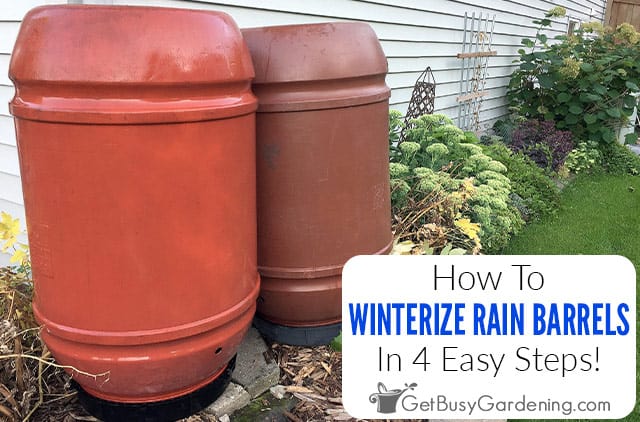
The other day my neighbor asked me what to do with her rain barrels in winter. She just got a couple this summer, and wasn’t sure what to do now that fall has arrived.
We live in Minnesota where the temperature is well below freezing for most of the winter. So it’s a no-brainer that the water would freeze solid if we left them outside.
Once it freezes solid, the ice could damage or destroy it very quickly. That’s why it’s so important to learn how to properly winterize your rain barrel.
It doesn’t matter what material it’s made of (wood, plastic, metal, etc), there’s no such thing as a freeze-proof or winter-safe rain barrel.
But don’t worry, I’m not adding yet another huge task to your fall garden chore list. It is actually very easy and doesn’t take much time. Below I’ll show you how to do it in 4 easy steps.
When To Winterize Your Rain Barrel
It’s best to winterize your rain barrel before the temperature drops below freezing in the fall. That way you won’t risk the water freezing before you have a chance to drain it.
If it’s already frozen, don’t bang on the sides to dislodge the ice, or you could break your rain barrel. Instead, move it to a sunny spot, or somewhere warm like a garage or shed so it can melt.
How To Winterize A Rain Barrel
There are just four steps you need to follow in order to protect your rain barrel from harsh winter weather.
- Drain all of the water out of the rain barrel
- Detach it from the gutter downspout or diverter
- Remove the spigots, hose attachments, and the lid
- Replace the missing gutter, or winterize the diverter
Related Post: How Do Rain Barrels Work?
Step 1: Drain The Rain Barrel
The very first step is to drain it. Before I drain mine completely, I like to fill up a bunch of jugs with the rainwater first. That way I can continue using it on my indoor plants.
To drain it, simply open up the spigot all the way, and let the water pour out. Once it drops below the level of the spigot, it should be light enough to tip in order to drain out the rest.
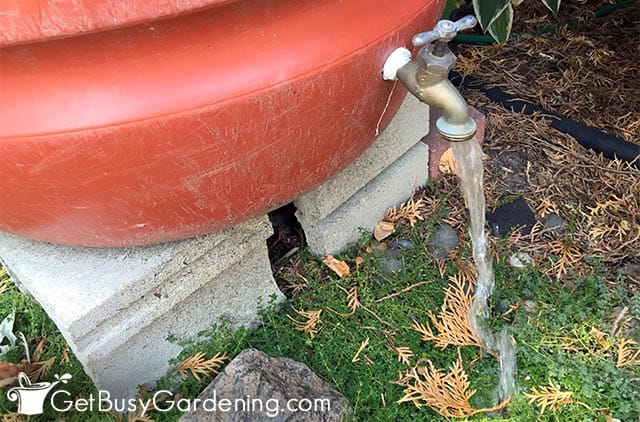
Step 2: Detach It From The Downspout
Next, unhook your rain barrel from the downspout. This should be a fairly straightforward step. The downspout tubing on mine just lays over the top, and is not attached to the barrel.
If yours is attached to the downspout, you may need a screwdriver or pliers to remove it. If you are struggling, don’t force it, you don’t want to accidentally break it.
Step 3: Remove The Rain Barrel Lid & Attachments
Next, remove everything that is attached to the rain barrel. This includes the lid, spigot(s), hose, tubing, and any other attachments.
It’s important to remove everything because if water gets between them and freezes, it could damage the parts and/or the barrel.
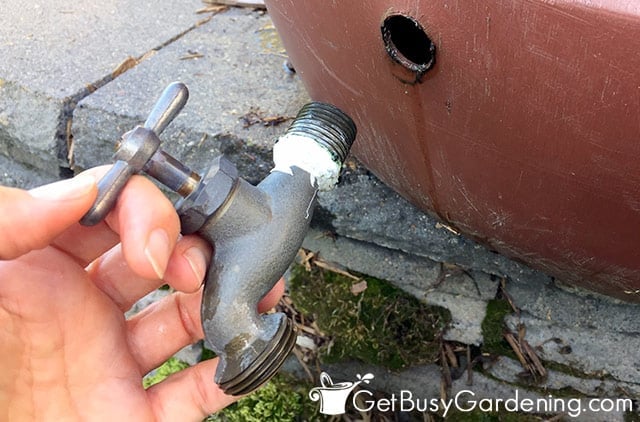
Step 4: Replace The Missing Gutter Or Winterize The Diverter
Don’t forget to reattach any gutters you removed when you installed your rain barrel, you’ll definitely want those in working condition come spring.
If you have a downspout diverter, it should come with a plug that you can install, or a lever you can switch over to winterize it.
That way, the water will run through the gutter like normal, and you don’t need to remove it to winterize it.
Related Post: How To Set Up A Rain Barrel Step-By-Step
Storing Your Rain Barrel For Winter
Before storing it, you might want to rinse the inside with the hose to remove any debris or algae built up. This is completely optional, but it’s a good time to clean it.
Storing your rain barrel inside a shed, basement, or garage will help extend its life. If you must leave it outside, find a spot where it will be protected from direct sunlight, wind, snow, and rain.
In that case, make sure it’s either closed tight or stored upside down to prevent water or snow from getting inside.
I keep mine behind some tall shrubs under the eves of the house where it’s completely protected from the elements.
Related Post: 7 Awesome Benefits Of Rain Barrels
Rain Barrel Winter Care FAQs
Below are some questions people often ask about winterizing rain barrels. If you don’t see your answer below, please ask it in the comments.
Can you use a rain barrel in the winter?
You can use a rain barrel in the winter and year-round if you live somewhere that never gets below freezing. Otherwise you must winterize and properly store it so it doesn’t get destroyed by the freezing cold.
How do I keep my rain barrel from freezing?
The best way to keep your rain barrel from freezing is to completely drain it and store it over winter. Store it upside down outside, or put it into the garage or a shed where it will be protected from precipitation.
How do you winterize a rain barrel diverter?
The easiest way to winterize a rain barrel diverter is to use either a plug or a switch to lock it into place so the rainwater will go through the downspout like normal.
Diverters are designed to stay on the gutter year-round, so there’s usually no need to remove it in the fall.
Can you leave a rain barrel out in the winter?
You can leave a rain barrel out in the winter as long as you protect it from the elements. Just make sure to store it upside down so the snow and rain can’t get inside to prevent damage.
When should you drain a rain barrel?
It’s best to drain your rain barrel in the fall before it starts to freeze. I recommend doing it before the nighttime temps drop below 40° F. It’s crazy how fast the water can solidify once it gets below freezing outside, so don’t put it off for too long.
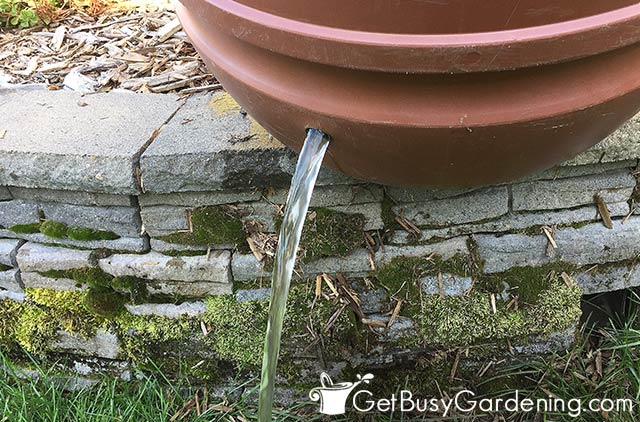
See, I told you that winterizing a rain barrel wasn’t that hard! It only takes me about 15 minutes to empty, detach, and store both of mine in the fall. It’s one of those “low hanging fruit” type chores that I always find myself doing first. So get it checked off the list!
Did you know that you can plant seeds outside in the snow and freezing cold, and they will grow in the spring? If you want to learn how, then grab a copy of my Winter Sowing eBook. It will show you exactly how to start your seeds outside in the dead of winter. Download your copy today!
More About Fall Gardening
- How To Winterize Your Garden In The Fall
- 5 Essential Fall Garden Tasks You Should Never Skip
- How To Winterize A Pond Step-By-Step
What steps do you take to winterize your rain barrel?
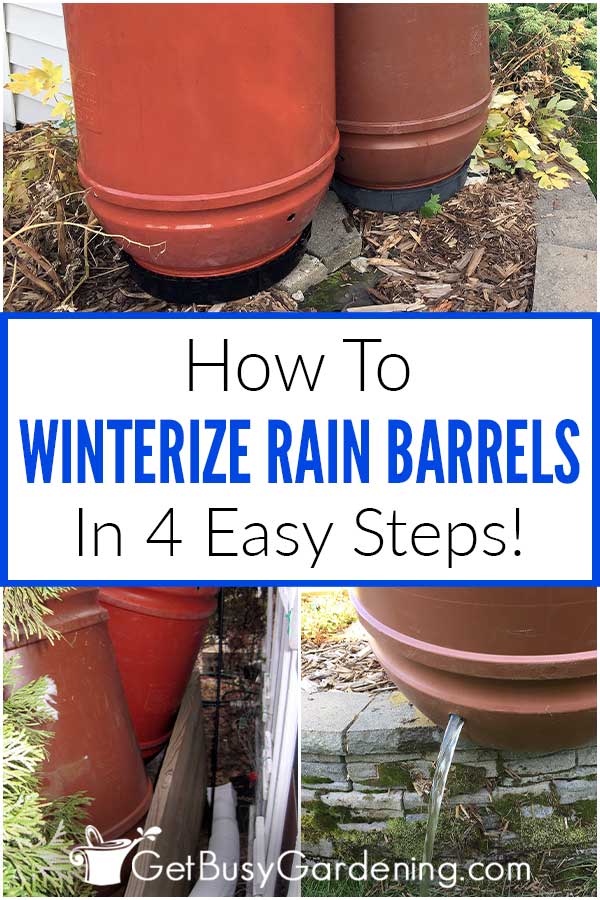
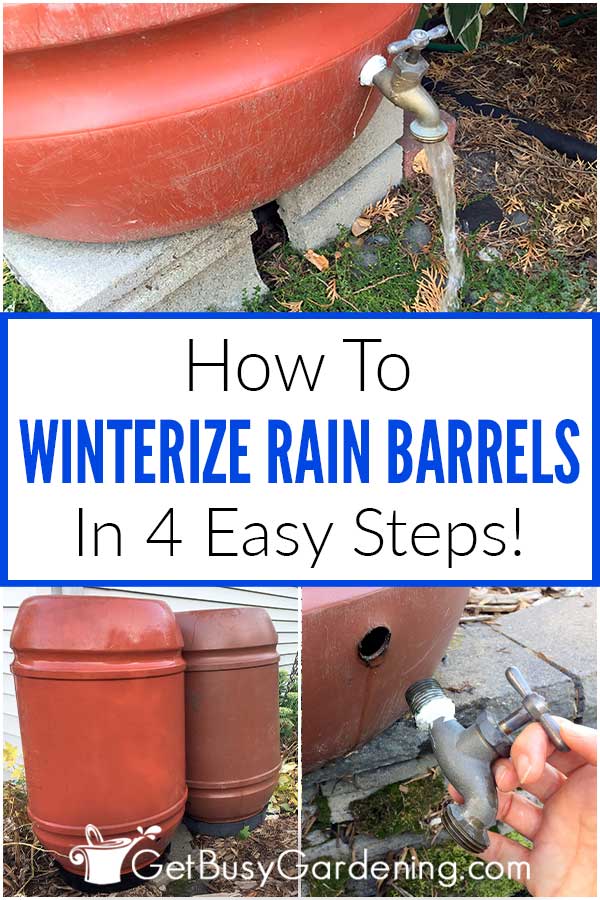
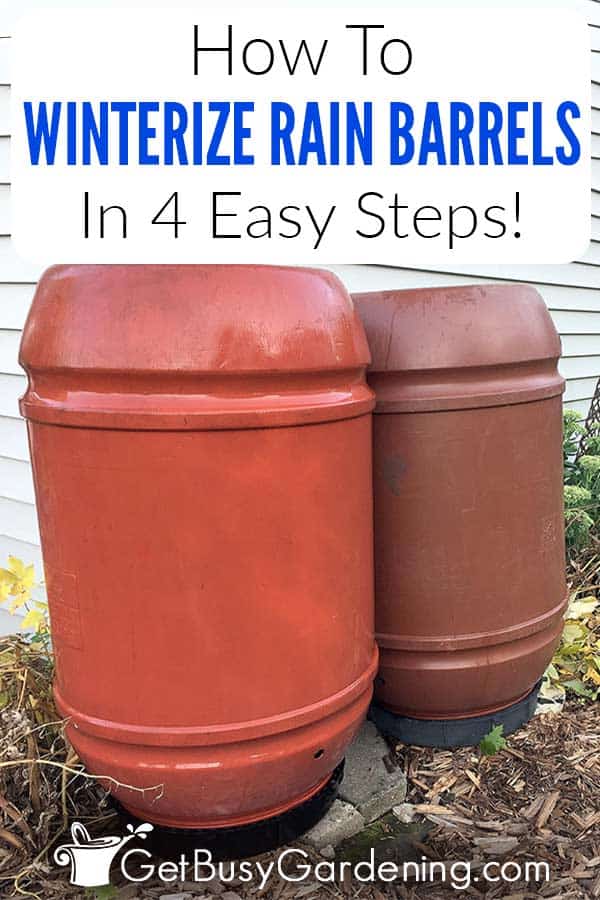

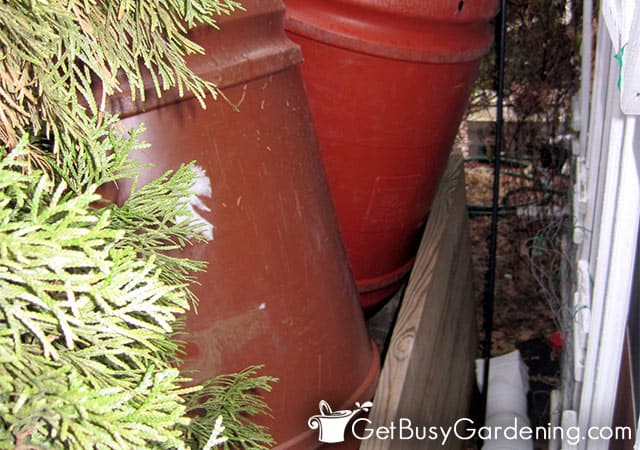


Laura says
The rain barrel collection system would need to be in a heated area. There must be off gridders who know how to do this properly.
Amy Andrychowicz says
I have never tried keeping my rain barrels heated through the winter, as it gets very cold in MN and I don’t want to risk breaking them if the heat system fails. But maybe someone else out there can speak to it and share their experience?
Brent says
What is a good way to keep the water from getting stagnant between collecting and use?
Amy Andrychowicz says
I’ve never had my rain barrel water become stagnant, mostly because it rains quite often in MN, so it flushes the water regularly. If yours has become stagnant, then it’s best to empty it and clean the barrel. To prevent it from happening in the first place, make sure to cover the opening with a screen to keep any organic matter out (i.e.: leaves, bugs, and other debris), and place the barrel in the shade to discourage algae growth. Here’s how I set mine up.
Ed B says
Should I use something other than clean water to rinse out the algae out of my rain barrel or just a good sloshing and brushing the areas I can reach (which is not ALL of the interior)?
Amy Andrychowicz says
I use the highest setting on my garden hose to spray off the algae I can’t reach at the bottom of my rain barrels. You definitely want to get as much of it out of there as possible.
Travis says
Put in 3-4 pure copper plumbing fittings , it will prevent algae from growing .
o lanzone says
can alcohol or anti freeze be added to a rain barrel to prevent freezing in winter?
Amy Andrychowicz says
No, I would definitely not recommend adding any type of chemical to your rain barrel to try to keep it from freezing. It would not work. Plus the water would be unusable for your plants, since using water that contains either of those would most certainly kill them. Your best bet would be to try using a stock tank heater. If you have mild winters, then that may keep the water from freezing. But it would not work in a cold climate like I live in here in MN. The only sure way to winterize your rain barrel without risking damage is to drain the water.
C P Stout says
I have installed recently a rain barrel in a small shed (open on one side) to catch water coming off one side of my garage. Will it freeze/crack in the winter if I leave a hose connected to it that is left open so that water will simply flow through rather than collect?
Amy Andrychowicz says
I definitely recommend you drain your rain barrel completely and remove the intake hose before winter. Otherwise it will most likely freeze either inside the hose or in the spigot/drainage hole.
Ethelyn says
I live further north and we must also BLOW out the lines of any irrigation lines or faucets.
Also, setting a rain barrel in the garage does NOT stop it from freezing here in SDakota. Our garages freeze even if attached to the house. They are only protection from lots of snow and freezing rain/wind/hail. Solid freezing occurs.
I am dreaming of a system that will save water and keep it in the garage in winter too, but with a rainwater deflection/on-off switch so if ‘winter’ doesn’t come at least I can save water. You see, we don’t have as much water here as you do in the south. When kept in the garage I will try to have it ‘syphoned’ to the basement where I can use it to water indoor plants/greenhouse. Rainwater is so much better than chlorinated water since I am promoting micro-organism growth.
Amy Andrychowicz says
Yes, we must blow out the lines of all of our irrigation systems here in MN too. My garage also freezes, and the only way to keep the water usable would be to heat it through the winter. Your idea for a rain barrel system you can use inside sounds great, good luck!
Amy says
Great advice – after buying a rain barrel, the last thing I want is for it to be ruined by the freezing cold in winter!
Amy Andrychowicz says
Yes, losing your rain barrel to freezing weather would be terrible! You’re welcome, glad I could help.